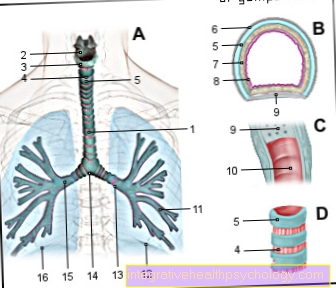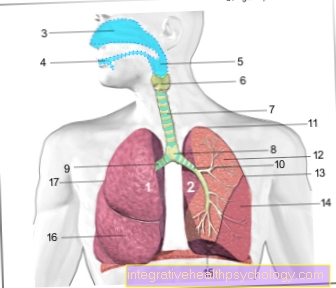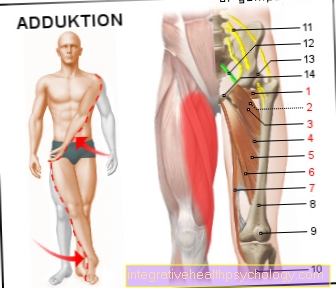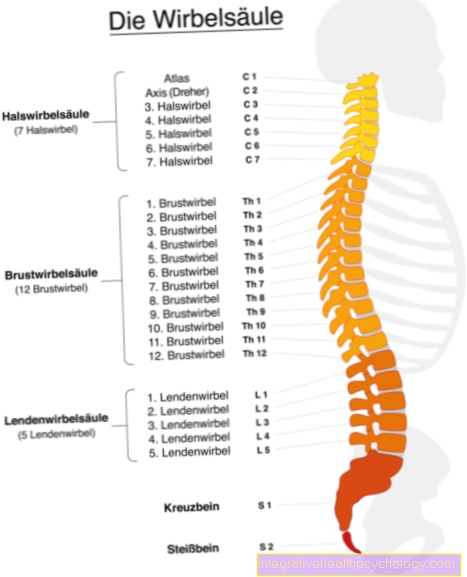Fluoroquinolones
introduction
Fluoroquinolones are a group of antibiotics that are particularly suitable for the treatment of so-called gram-negative rod bacteria.
Rod bacteria are all types of bacteria that look rather elongated under the microscope.
Gram negative describes a property that comes to light with a special staining method (Gram staining).
Gram-negative rods are mostly bacteria that are found in the digestive tract (so-called enterobacteria).
These can be treated particularly well by fluoroquinolones.
Newer substances from the group of fluoroquinolones are also effective against other groups of bacteria.
The fluoroquinolones are used as broad-spectrum antibiotics, for example as the first choice for urinary tract infections.

Indications
The indications for therapy with fluoroquinolones are diverse, since it is a class of antibiotics with a very broad spectrum of activity.
The earliest active ingredients of the fluoroquinolones are especially suitable for the therapy of enterobacteria (bacteria that occur in the digestive tract).
Therefore, they are often used for uncomplicated infections of the urinary tract, the urinary bladder and possibly the genital organs (for example an infection of the prostate).
These infections are often caused by smear infections from the intestines and therefore often respond to fluoroquinolones.
Serious gastrointestinal infections can also be treated with fluoroquinolones.
If necessary, therapy with, for example, ciprofloxacin is also suitable for treating acute inflammation of the pancreas.
Later generations of fluoroquinolones have a much broader spectrum of activity and can therefore also be used for infections of the respiratory tract or in the ear, nose and throat area.
Bacterial diseases of bones and joints can also be treated with fluoroquinolones such as levofloxacin.
In addition, the fluoroquinolones are of great importance in the treatment of so-called nosocomial infections (acquired in hospital / nursing care).
These are often infections with resistant bacteria, but these can often be treated well with fluoroquinolones such as moxifloxacin.
You can also read about the dangers posed by multi-resistant hospital germs:
Multi-resistant hospital germs
Active ingredient, effect
The term fluoroquinolone refers to a group of antibiotics that kill bacteria.
The fluoroquinolones include the active ingredients norfloxacin, ciprofloxacin, oflocazin, levofloxacin and moxifloxacin.
The fluoroquinolones develop their effect via a so-called gyrase inhibition.
Gyrase is an enzyme that is required in bacteria to multiply the genetic material.
The gyrase of bacteria is also called topoisomerase II.
By inhibiting this topoisomerase II, the bacteria can no longer copy their genetic material (= their DNA).
The growth of the bacterial colony is inhibited (bacteriostatic) and the bacteria then die (bactericidal).
In addition to gyrase inhibition, other mechanisms of action of fluoroquinolones are also discussed, as their effectiveness cannot be explained by the inhibition of gyrase alone.
So far, however, no specific mechanisms of action have been confirmed in experiments.
The mode of action of the fluoroquinolones is particularly effective because the active ingredient is very tissue-permeable.
This property describes the ability of the fluoroquinolones to spread particularly well in the tissue.
Therefore they are well suited for the treatment of many tissue infections including bones.
side effect
Like all antibiotics, fluoroquinolones have side effects, which are primarily based on their desired effect (killing bacteria).
Treatment with fluoroquinolones not only kills the disease-causing bacteria, but also the growth of naturally occurring bacteria in the digestive tract and on the skin can be inhibited and killed by fluoroquinolones.
As a result, there are mainly side effects in the digestive tract such as nausea, vomiting, diarrhea and abdominal pain.
Killing the bacteria on the skin causes problems, especially in people with a weakened immune system.
Instead of the protective bacteria, other pathogens such as fungi settle on the skin.If these cannot be fought adequately by the immune system, a fungal infection occurs.
Other side effects of fluoroquinolones include disorders of nerve functions.
This manifests itself in the form of memory disorders or disorders of the senses (seeing, hearing, smelling, tasting, feeling).
In connection with therapy with fluoroquinolones, joint and muscle pain also occur more frequently, and tendon injuries are also more common.
Other types of tissue, such as vascular walls, can also be affected, so that norfloxacin, for example, increases the risk of heavy bleeding in an aortic aneurysm (bulging of the main artery).
The heart rhythm can also be influenced by fluoroquinolones such as ciprofloxacin.
As a side effect, the so-called QT time can be increased.
If the liver has already been damaged, the fluoroquinolones can also cause severe liver failure; acute liver failure has rarely been reported in people with healthy liver.
interaction
Fluoroquinolones can interact with a variety of drugs.
Particular attention should be paid to drugs that have side effects similar to fluoroquinolones.
For example, there may be interactions with drugs that are used for cardiac arrhythmias.
Metabolic pathways also play a major role in interactions.
For example, ciclosporin and fluoroquinolones are both partially excreted via the kidneys.
Simultaneous therapy with both active ingredients can damage the kidneys.
In the liver, on the other hand, there can be an interaction with blood thinners such as Marcumar®.
Since there are several classes of fluoroquinolones, the interactions cannot be fully illustrated.
The prescribing information should be checked for possible interactions with fluoroquinolones for any person taking multiple drugs.
Contraindications - When should not be given?
Fluoroquinolones must not be given if there is allergies or intolerance to the active ingredient or other substances contained in the drug.
Renewed treatment with fluoroquinolones should also be avoided in the event of severe side effects after fluoroquinolone therapy.
For example, anyone who has had central nervous side effects or visual problems during / after fluoroquinolone therapy should be treated with other antibiotics in the future.
Diseases such as epilepsy are also contraindications for therapy with fluoroquinolones.
In the absence of adequate data, some fluoroquinolones should also not be used in children and adolescents or during pregnancy or breastfeeding.
dosage
The dosage of the fluoroquinolones depends on various criteria.
Different dosages are used in different fluoroquinolone classes.
The body weight of the person being treated and the severity of the disease also play a role.
Norfloxacin is typically prescribed at a dosage of 400 mg twice a day.
Ciprofloxacin can be taken in doses between 250 and 500 mg twice a day.
For levofloxacin, a dose of 500 mg per day is usually recommended; moxifloxacin has a maximum dose of 400 mg per day.
Particular attention must be paid to the dosage in diseases of the liver and kidneys.
The dosage usually has to be adjusted (reduced) based on the liver or kidney function that is still present.
price
The price for the fluoroquinolones depends on the active ingredient class, the amount of the active ingredient and the dosage form.
For people who are treated with fluoroquinolones in the form of tablets, there is usually only the prescription fee of € 5.
The rest of the costs are covered by the health insurance.
If fluoroquinolones are administered into the vein (for example, as part of inpatient therapy), nothing usually has to be paid for the fluoroquinolone treatment.
Fluoroquinolones and alcohol - are they compatible?
Fluoroquinolones are primarily metabolized in the liver and then excreted in both the liver and the kidneys.
There are therefore interactions when consuming alcohol.
Alcohol also has to be metabolized in the liver.
Therefore, if the substances are present in the body at the same time, they can influence each other.
For example, the effective levels of the fluoroquinolones can increase, as the alcohol in the body slows down the breakdown of the active ingredient.
Alcohol can also prevent the fluoroquinolones from being converted to their effective form in the liver.
A reduced effectiveness of the antibiotics can be caused by alcohol consumption.
In addition, the breakdown of fluoroquinolones and alcohol can be slowed down, which is why high blood alcohol levels can be reached even with little alcohol consumption.
Alternatives to fluoroquinolones
Alternatives to fluoroquinolones are usually offered by other antibiotics.
Antibiotic agents such as penicillins and cephalosporins are often used in bacterial infections.
The exact effectiveness of the various substances can be seen from the antibiogram.
The bacteria that are obtained from the body are grown in a so-called culture, then typical antibiotics are tested for their effectiveness on precisely these bacteria.
After this test, a statement can be made about which antibiotics the bacteria are sensitive to (they can be treated with these antibiotics) and to which they are resistant.
This sensitivity and resistance is shown in the antibiogram.
Therefore, alternative active ingredients can be read on the antibiogram after a few days.
Can be taken during pregnancy and breastfeeding?
Most fluoroquinolones should not be used during pregnancy or breastfeeding.
On the one hand, this is due to the fact that insufficient data are available on whether the fluoroquinolones can harm the unborn or breast-fed child.
In some cases, however, data are also available that indicate possible damage, which is why the newer fluoroquinolones are not used during pregnancy and breastfeeding.
Only fluoroquinolones from the first group, such as norfloxacin, can be taken during breastfeeding after carefully weighing the benefits and risks.
They are also not recommended during pregnancy.
Find out more about antibiotics and their use during pregnancy and breastfeeding in our separate articles:
Antibiotics in Pregnancy
Antibiotics while breastfeeding
Effectiveness of the pill
Due to the common metabolic processes of fluoroquinolones and the pill, taking the medication at the same time can make the pill less effective.
Tests have not been conducted for all types of fluoroquinolones with the various pills available on the market.
However, in some experiments there were interactions with reduced effectiveness of the pill.
Therefore, one should assume that the effectiveness of the pill is reduced if fluoroquinolones are taken at the same time.





























